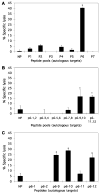CTL from EIAV carrier horses with diverse MHC class I alleles recognize epitope clusters in Gag matrix and capsid proteins
- PMID: 15327905
- PMCID: PMC3342308
- DOI: 10.1016/j.virol.2004.06.035
CTL from EIAV carrier horses with diverse MHC class I alleles recognize epitope clusters in Gag matrix and capsid proteins
Abstract
Cytotoxic T lymphocytes (CTL) are important for controlling equine infectious anemia virus (EIAV). Because Gag matrix (MA) and capsid (CA) are the most frequently recognized proteins, the hypothesis that CTL from EIAV-infected horses with diverse MHC class I alleles recognize epitope clusters (EC) in these proteins was tested. Four EC were identified by CTL from 15 horses and 8 of these horses had diverse MHC class I alleles. Two of the eight had CTL to EC1, six to EC2, five to EC3, and four to EC4. Because EC2-4 were recognized by CTL from >50% of horses with diverse alleles, the hypothesis was accepted. EC1 and EC3 were the most conserved EC and these more conserved broadly recognized EC may be most useful for CTL induction, helping overcome MHC class I polymorphism and antigenic variation.
Figures



Similar articles
-
Early detection of dominant Env-specific and subdominant Gag-specific CD8+ lymphocytes in equine infectious anemia virus-infected horses using major histocompatibility complex class I/peptide tetrameric complexes.Virology. 2005 Aug 15;339(1):110-26. doi: 10.1016/j.virol.2005.05.025. Virology. 2005. PMID: 15979679 Free PMC article.
-
Evaluation of high functional avidity CTL to Gag epitope clusters in EIAV carrier horses.Virology. 2005 Nov 25;342(2):228-39. doi: 10.1016/j.virol.2005.07.033. Epub 2005 Sep 1. Virology. 2005. PMID: 16139857 Free PMC article.
-
Gag protein epitopes recognized by ELA-A-restricted cytotoxic T lymphocytes from horses with long-term equine infectious anemia virus infection.J Virol. 1998 Dec;72(12):9612-20. doi: 10.1128/JVI.72.12.9612-9620.1998. J Virol. 1998. PMID: 9811694 Free PMC article.
-
Cytotoxic T lymphocytes in protection against equine infectious anemia virus.Anim Health Res Rev. 2004 Dec;5(2):271-6. doi: 10.1079/ahr200482. Anim Health Res Rev. 2004. PMID: 15984338 Review.
-
[Study on the role of cytotoxic T lymphocytes during equine infectious anemia virus infection and its epitope specificity].Bing Du Xue Bao. 2007 Jan;23(1):76-8. Bing Du Xue Bao. 2007. PMID: 17886727 Review. Chinese. No abstract available.
Cited by
-
Epitope shifting of gp90-specific cellular immune responses in EIAV-infected ponies.Vet Immunol Immunopathol. 2014 Oct 15;161(3-4):161-9. doi: 10.1016/j.vetimm.2014.08.001. Epub 2014 Aug 10. Vet Immunol Immunopathol. 2014. PMID: 25176006 Free PMC article.
-
A single amino acid difference within the alpha-2 domain of two naturally occurring equine MHC class I molecules alters the recognition of Gag and Rev epitopes by equine infectious anemia virus-specific CTL.J Immunol. 2006 Nov 15;177(10):7377-90. doi: 10.4049/jimmunol.177.10.7377. J Immunol. 2006. PMID: 17082657 Free PMC article.
-
DNA vaccination with a gene encoding Toxoplasma gondii GRA6 induces partial protection against toxoplasmosis in BALB/c mice.Parasit Vectors. 2011 Nov 9;4:213. doi: 10.1186/1756-3305-4-213. Parasit Vectors. 2011. PMID: 22070984 Free PMC article.
-
The determination of in vivo envelope-specific cell-mediated immune responses in equine infectious anemia virus-infected ponies.Vet Immunol Immunopathol. 2012 Aug 15;148(3-4):302-10. doi: 10.1016/j.vetimm.2012.06.018. Epub 2012 Jun 23. Vet Immunol Immunopathol. 2012. PMID: 22795699 Free PMC article.
-
Early detection of dominant Env-specific and subdominant Gag-specific CD8+ lymphocytes in equine infectious anemia virus-infected horses using major histocompatibility complex class I/peptide tetrameric complexes.Virology. 2005 Aug 15;339(1):110-26. doi: 10.1016/j.virol.2005.05.025. Virology. 2005. PMID: 15979679 Free PMC article.
References
-
- Anton LC, Yewdell JW, Bennink JR. MHC class I-associated peptides produced from endogenous gene products with vastly different efficiencies. J Immunol. 1997;158:2535–2542. - PubMed
-
- Bailey E. Identification and genetics of horse lymphocyte alloantigens. Immunogenetics. 1980;11:499–506. - PubMed
-
- Bailey E, Marti E, Fraser DG, Antczak DF, Lazary S. Immunogenetics of the horse. In: Bowling AT, Ruvinsky A, editors. The Genetics of the Horse. CABI Publishing Inc; UK: 2000. pp. 123–155.
-
- Bernoco D, Byrns G, Bailey E, Lew AM. Evidence of a second polymorphic ELA class I (ELA-B) locus and gene order for three loci of the equine major histocompatibility complex. Anim Genet. 1987;18:103–118. - PubMed
Publication types
MeSH terms
Substances
Grants and funding
LinkOut - more resources
Full Text Sources
Research Materials

